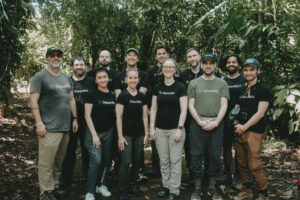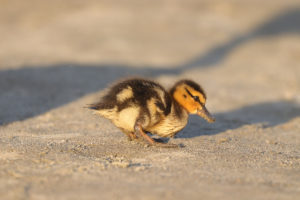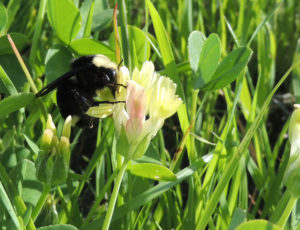
Last year, as part of a global citizen science competition, I sat down in a park in the middle of San Francisco and watched a shrub vibrating with insect pollinators, like in a cartoon when the animators want you to know there’s someone hiding inside. From maybe 10 feet away I thought it was just a cloud of honeybees. But from an arm’s length the vibration turned into a taxonomic buffet: dozens and dozens of different kinds of bees, flies, and butterflies, buzzing around this one shrub in a single park in an enormous city.
One small bee in particular caught my eye. Its pollen-drenched legs and back shone bright gold, while its abdomen, upon close inspection, was a sort of shimmery, metallic blue. It had a fuzzy coat, speckled with pollen dust. I had no idea what it was, beyond that it was not a honeybee. Small bees are notoriously difficult to identify from photographs, but in this case I got lucky: John Stoskopf Ascher, an assistant professor at the National University of Singapore who has identified more than 150,000 bees on the citizen science app and website iNaturalist, could identify not just the family but the species: a blue-and-black mining bee, Andrena nigrocaerulea.
It turned out to be the first observation of this species for the iNaturalist database and, for me, the beginning of a year of slowly learning about mining bees, bee diversity, and—as always seems to be the case with insects—how little we still know about them.
The mining bee family Andrenidae is tough to get to know. Even the name itself hearkens back to Greek words for “any buzzing insect.” They are, for all this, among our most common wild bees. According to the Field Guide to the Common Bees of California, by San Francisco State University ecologist Gretchen LeBuhn, there are more than 2,500 Andrenidae species worldwide and more than 500 species in three genera in California. The andrenids tolerate cold better than honeybees do and so might be especially important pollinators in cool coastal regions like the Bay Area.
Unlike honeybees, mining bees are generally solitary creatures. They take their common name from the underground nests they dig each year. After mating in the spring, females build a roughly eight-chambered burrow, laying one egg in each chamber.
The largest genus in the mining bee family is Andrena, which is also, conveniently, called mining bees. The second-largest genus, Perdita, is also called mining bees. There is a genus called Anthophora, which also goes by the name “mining bees” but is in the Apidae family with bumblebees and honeybees. Almost none of the hundreds of species in those genera even have common names, or in other words, if you see it digging a hole, just call it a mining bee.
Even without common names, Andrena is likely the largest and most species-diverse bee genus in California, says urban bee researcher and garden designer Jaime Pawelek.
It presumably helps a nonspecialist very little to say that you can identify a mining bee by its face, but then that’s insects for you. Look for two “sutures”: black lines below the antenna sockets. Bees in Andrena also have what are called facial foveae: hair-lined depressions between their eyes and antennae. Picture basically each eye as having its own hedgerow and you will get the idea. Are you likely to be that close to a bee with a face the size of this question mark? That’s up to you, but I recommend it if you can.
The blue-and-black mining bee I saw turns out to be easy to identify: its body is quite blue relative to the others, and its hair tends to be black rather than blond. Right now, and for the next month or two, andrenid bees will be out finishing up their work for the year. You can sometimes see a solitary female gathering one last load of food to take back to the mines in the winter. Then they’ll crawl down their food-lined holes and hibernate, emerging again in the warmth of spring. Eggs laid over the summer will pupate and hatch at the same time.
Tiny and solitary as they are, mining bees unlock for me some essential wonder about the universe. That there are so many of these things, that they come in such variety, that even still in our most urban areas and neighborhood parks they’re little studied or understood. That the world we don’t always take time to see or name is as creative and fascinating as the one we do.




